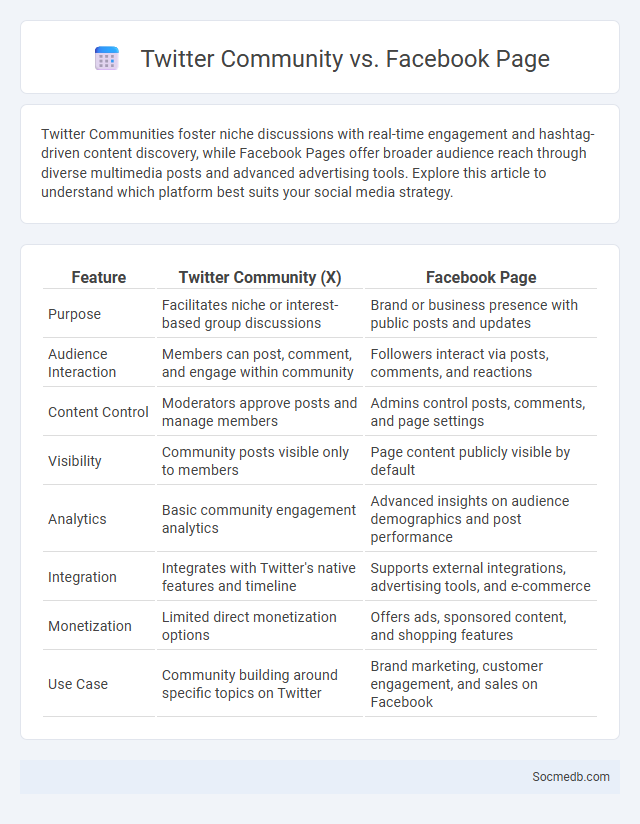
Photo illustration: Twitter Community vs Facebook Page
Twitter Communities foster niche discussions with real-time engagement and hashtag-driven content discovery, while Facebook Pages offer broader audience reach through diverse multimedia posts and advanced advertising tools. Explore this article to understand which platform best suits your social media strategy.
Table of Comparison
| Feature | Twitter Community (X) | Facebook Page |
|---|---|---|
| Purpose | Facilitates niche or interest-based group discussions | Brand or business presence with public posts and updates |
| Audience Interaction | Members can post, comment, and engage within community | Followers interact via posts, comments, and reactions |
| Content Control | Moderators approve posts and manage members | Admins control posts, comments, and page settings |
| Visibility | Community posts visible only to members | Page content publicly visible by default |
| Analytics | Basic community engagement analytics | Advanced insights on audience demographics and post performance |
| Integration | Integrates with Twitter's native features and timeline | Supports external integrations, advertising tools, and e-commerce |
| Monetization | Limited direct monetization options | Offers ads, sponsored content, and shopping features |
| Use Case | Community building around specific topics on Twitter | Brand marketing, customer engagement, and sales on Facebook |
Introduction to Online Communities
Online communities are virtual spaces where individuals connect through shared interests, goals, or activities, fostering collaboration and social interaction. Platforms such as Facebook, Reddit, and Discord enable users to engage in discussions, share content, and build relationships across diverse topics and demographics. These digital networks enhance information exchange, support systems, and collective learning within various social and professional contexts.
What is a Twitter Community?
A Twitter Community is a dedicated space within Twitter where users with shared interests can engage, share content, and participate in focused conversations. Your participation in a Twitter Community allows you to connect with like-minded individuals, fostering deeper interaction and more relevant discussions. These Communities enhance your social media experience by providing a targeted environment for networking and information exchange.
Understanding Facebook Pages
Facebook Pages serve as powerful tools for businesses, brands, and public figures to establish an online presence and engage with their audience effectively. Optimizing a Facebook Page involves detailed customization of profile information, consistent content posting, and leveraging Facebook Insights to analyze user interactions and improve engagement strategies. Utilizing features like Call-to-Action buttons, targeted advertising, and community management enhances visibility and drives meaningful connections on the platform.
Facebook Community Explained
Facebook Community fosters meaningful connections by bringing users together around shared interests, experiences, or causes. Your participation enables engagement through posts, comments, and events that drive collaboration and support. Leveraging Facebook's tools like Groups, admins can moderate discussions and promote a sense of belonging among members.
Key Features Comparison
Social media platforms offer distinct key features tailored to different user needs, such as Facebook's comprehensive networking capabilities, Instagram's emphasis on visual content sharing, and Twitter's real-time microblogging format. You can leverage Facebook Groups for community building, Instagram Stories for engaging, ephemeral content, and Twitter's trending hashtags to stay updated on global conversations. Understanding these features allows you to select the best platform to maximize your social engagement and brand visibility.
Audience Engagement and Interaction
Social media platforms drive audience engagement through interactive content such as polls, live videos, and stories that encourage real-time participation. High engagement rates are achieved by targeting specific demographics with personalized posts, fostering authentic conversations and community building. Metrics like comments, shares, and click-through rates serve as key indicators of effective audience interaction and content resonance.
Content Moderation and Control
Content moderation on social media platforms involves filtering harmful, inappropriate, or misleading material to create a safer online environment. Algorithms combined with human moderators ensure compliance with community guidelines while balancing free expression and user safety. Your engagement relies on effective content control mechanisms that protect against spam, hate speech, and misinformation.
Marketing and Growth Potential
Social media platforms drive unprecedented marketing reach by enabling targeted advertising and real-time consumer engagement across billions of active users. Leveraging analytics and influencer partnerships amplifies brand visibility and accelerates growth potential through data-driven strategies. Continuous innovation in content formats, such as short-form videos and interactive stories, enhances audience retention and conversion rates for businesses worldwide.
Privacy and Accessibility
Social media platforms continuously improve privacy settings to protect your personal data from unauthorized access and enhance user control over information sharing. Accessibility features such as screen readers, captioning, and customizable interfaces ensure that users with disabilities can engage equally and effectively. Prioritizing these aspects fosters a safer and more inclusive online environment, empowering your social media experience.
Choosing the Right Platform for Your Needs
Selecting the right social media platform depends heavily on your target audience and content type, with options ranging from Instagram for visual storytelling to LinkedIn for professional networking. Understanding the demographics and engagement patterns on each platform helps maximize your brand's reach and interaction. Your choice should align strategically with your goals to ensure efficient use of resources and enhanced visibility.
 socmedb.com
socmedb.com